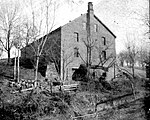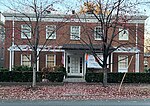Abell–Gleason House
Charlottesville, Virginia Registered Historic Place stubsGreek Revival houses in VirginiaHouses completed in 1859Houses in Charlottesville, VirginiaHouses on the National Register of Historic Places in Virginia ... and 3 more
Individually listed contributing properties to historic districts on the National Register in VirginiaNRHP infobox with nocatNational Register of Historic Places in Charlottesville, Virginia

Abell–Gleason House is a historic home located at Charlottesville, Virginia. It was built in 1859, and is a two-story, three-bay, Greek Revival style brick dwelling. Each of the bays is defined by brick pilasters with Doric order inspired capitals faced with stucco. Also on the property is a contributing four room servants quarters.It was listed on the National Register of Historic Places in 2001. It is located in the Charlottesville and Albemarle County Courthouse Historic District.
Excerpt from the Wikipedia article Abell–Gleason House (License: CC BY-SA 3.0, Authors, Images).Abell–Gleason House
1st Street North, Charlottesville
Geographical coordinates (GPS) Address Nearby Places Show on map
Geographical coordinates (GPS)
| Latitude | Longitude |
|---|---|
| N 38.035 ° | E -78.48 ° |
Address
1st Street North
22902 Charlottesville
Virginia, United States
Open on Google Maps











